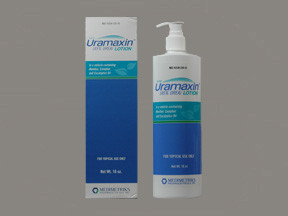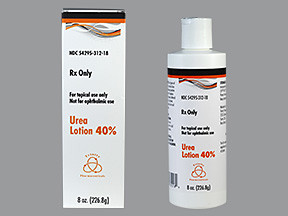KERATOLYTIC EMOLLIENTS - TOPICAL
PHONETIC PRONUNCIATION:
GENERIC NAME(S): urea
Uses
USES: This medication has 2 types of ingredients (emollient, keratolytic) that work together to treat or prevent dry, rough, scaly, itchy skin (e.g., eczema, keratosis, xerosis). Dry skin is caused by a loss of water in the upper layer of the skin. Emollients are substances that soften and moisturize the skin and decrease itching and flaking. Emollients/moisturizers work by forming an oily layer on the top of the skin that traps water in the skin. Petrolatum, lanolin, mineral oil, and dimethicone are common emollients. Lactic acid, salicylic acid, and urea are keratolytics. They increase moisture in the skin by softening/dissolving the horny substance (keratin) holding the top layer of skin cells together. This helps the dead skin cells fall off and helps the skin keep more water in. Higher strengths of urea are used to treat corns, callous, and some nail problems (e.g., ingrown nails). Urea is also used to help remove dead tissue in some wounds to help wound healing.
How to use KERATOLYTIC EMOLLIENTS - TOPICAL
HOW TO USE: Use this product as directed. Follow all directions on the product package and prescription label. If you are uncertain about any of the information, consult your doctor or pharmacist. Some products need to be shaken before use. Check the label to see if you should shake the bottle well before using. Apply to the affected areas of the skin, usually 1-3 times a day or as directed by your doctor. Rub in well until absorbed. How often you apply the medication will depend on the product and your skin condition. Apply to the skin/nails only. Avoid sensitive areas such as your eyes, lips, inside your mouth/nose, and the vaginal/groin area, unless your doctor directs you otherwise. Ask your doctor or check the label for directions about any areas or types of skin where you should not apply the product (e.g., on the face, any areas of broken/chapped/cut/irritated/scraped skin, or on a recently shaved area of the skin). Consult your doctor or pharmacist for more details. Use this medication regularly to get the most benefit from it. Most moisturizers need water to work well. Apply the product after bathing/showering/shampooing while the skin is still damp. For very dry skin, your doctor may instruct you to soak the area before using the product. Long, hot, or frequent bathing/washing can worsen dry skin. Inform your doctor if your condition persists or worsens.
Side Effects
Precautions
Interactions
Overdose
Images
Reviews
Faq for KERATOLYTIC EMOLLIENTS - TOPICAL
A keratolytic emollient is a topical product that contains certain ingredients that help exfoliate and soften the outer layer of the skin, promoting cell turnover and removing dead skin cells.
Keratolytic emollients work by breaking down the protein keratin, which forms the outer layer of the skin. This helps to loosen and remove dead skin cells, leaving the skin smoother and softer.
Keratolytic emollients are commonly used to treat conditions such as dry skin, rough patches, calluses, corns, and certain types of acne. They can also be helpful in preventing ingrown hairs and improving the texture of the skin.
Keratolytic emollients are generally safe to use when used as directed. However, some people may be allergic to certain ingredients, so it's important to patch test a small area of skin before applying it to a larger area.
Keratolytic emollients should be applied as directed by the product instructions or as advised by a healthcare professional. Typically, they are applied to clean, dry skin and massaged gently until fully absorbed.
Some people may experience mild skin irritation, redness, or a burning sensation when using keratolytic emollients. If these side effects persist or worsen, it's recommended to stop using the product and consult a healthcare professional.
The time it takes to see results with keratolytic emollients can vary based on the individual and the specific condition being treated. In general, improvements can be noticed within a few days to a few weeks of regular use.
Keratolytic emollients can be used on sensitive skin, but it's always advisable to consult with a healthcare professional or dermatologist before using them, especially if you have a history of skin allergies or sensitivities.
While some keratolytic emollients may be safe to use during pregnancy or breastfeeding, it's recommended to consult with a healthcare professional before using any topical products to ensure safety for you and your baby.
Disclaimer
IMPORTANT: HOW TO USE THIS INFORMATION: This is a summary and does NOT have all possible information about this product. This information does not assure that this product is safe, effective, or appropriate for you. This information is not individual medical advice and does not substitute for the advice of your health care professional. Always ask your health care professional for complete information about this product and your specific health needs.



No Reviews Yet